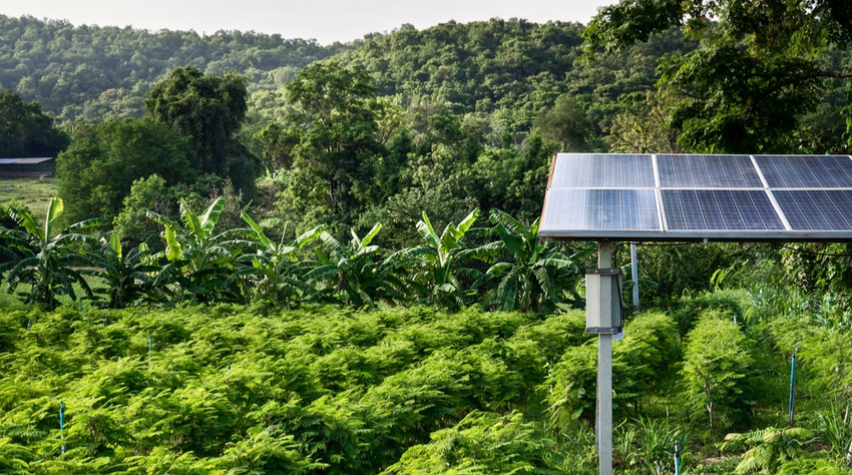
By Lucy Lyudmila Alexander, Hailey Murphy, Amro Tambal, and Derrick Wu
Steve Jobs is quoted as saying, “Innovation distinguishes between a leader and a follower.” AIChE’s Technical Entities, which cover a wide variety of topics that include food, energy, water, sustainability, and biological engineering, are at the forefront of innovation. This article highlights some recent innovations that are helping to progress their respective fields.
Food and energy
Farmers and photovoltaic (PV) companies have typically competed for large plots of land. The Fraunhofer Institute for Solar Energy Systems’ pilot project in Germany, however, has shown that agrophotovoltaics (APVs) can enable crop growth and electricity generation in the same area. The demonstration project recently reported its first harvest of both crops and power. “The crop production is sufficiently high and can be profitably sold on the market,” says the project manager. The system produced one-third more electricity than the average for a plot of its size in Germany.
The system includes rows of bifacial glass PV modules — which capture light on both sides — installed 5 m above the crops. Further testing (e.g., with different crops) and technology implementation (e.g., energy storage) is still required, but APVs could ultimately improve resource efficiency and give farmers a new source of income.
Water
Digital innovations in the water sector are helping to collect and store data, as well as monitor data in real time to improve processes. The Microsoft-Ecolab partnership, for example, collects water quality data from thousands of facilities globally and securely stores it in the cloud. Local monitoring equipment can use these data to control various processes; for example, a company could access the data to determine whether a wastewater stream is clean enough to be reused in a cooling tower.
In addition, digital innovations can be used for predictive analytics and asset management. Engineers can use such data to predict and prepare for disruptions in water processes and minimize the time needed for repairs. Sensors can help detect leaks, minimize energy usage, and manage storm-water overflows.
Sustainability
Electric vehicles (EVs) have the potential to be more energy-efficient and produce less pollution than conventional vehicles. EVs have become competitive with their gasoline-fueled counterparts in terms of safety, acceleration, and operability, as well as range and cost. Researchers have developed new technology to address the remaining obstacle: refueling time.
Wireless electric vehicle charging (WEVC) technology enables a car parked in a designated parking spot to charge wirelessly overnight. With high-power wireless charging, this process could take as little as 10 min. Dynamic electric vehicle charging (DEVC) wirelessly charges an EV while it is being driven (or drives itself) in a special lane.
These technologies are becoming a reality thanks to the research conducted by several national laboatories in collaboration with major automotive companies. Their work has informed SAE International’s new recommended practice (RP), which establishes industry-wide specifications for testing wireless charging of light-duty and plug-in EVs.
Biological engineering
Innovations across the various fields of biological engineering could help save lives. Rare diseases affect more than 350 million people worldwide, and 80% of those rare diseases are caused by faulty genes. CRISPR is an innovative and popular genome-editing system that can be used to remove the faulty gene to treat or prevent disease.
Many scientists are working to improve the CRISPR system. For example, researchers from the Massachusetts Institute of Technology (MIT) and the Institute for Medical Engineering and Science developed a nanoparticle that can deliver Cas9 — the CRISPR genome-editing enzyme — and RNA, which is essential in guiding the enzyme, to the target site. This method has been used successfully in mice to eradicate a specific cholesterol-regulating gene in 80% of their liver cells. The nanoparticles would also replace the need to use viruses for the Cas9 delivery system.
Regenerative medicine
As of August 2017, more than 116,000 people were waiting to receive an organ transplant and 20 people die each day waiting to receive a transplant in the U.S. Researchers in the field of regenerative medicine have made great strides in producing artificial organs to meet this pressing need. Researchers have used 3D printing to create customized scaffolds to promote the regrowth of organ tissue cells within the body.
The challenge, however, is scaling up these techniques from laboratory to large-scale production methods. In December 2016, the U.S. Dept. of Defense (DOD) launched the Advanced Regenerative Manufacturing Institute (ARMI) as a part of Manufacturing USA — a consortium of public and private research institutes that is focused on advancing manufacturing technologies — to address this challenge.
Innovation is necessary to progress every engineering discipline and field of research. Take inspiration from the examples presented here and you may contribute to the next great engineering innovation.
This article originally appeared in the "Technical Entity Trends" column in the January 2018 issue of CEP magazine. Members have access online to complete issues, including a vast, searchable archive of back-issues found at aiche.org/cep.


